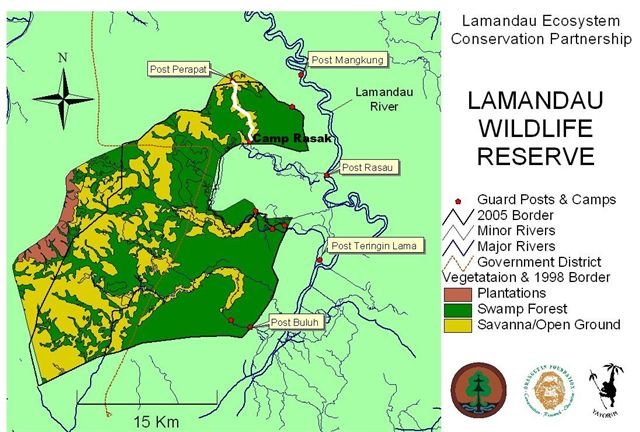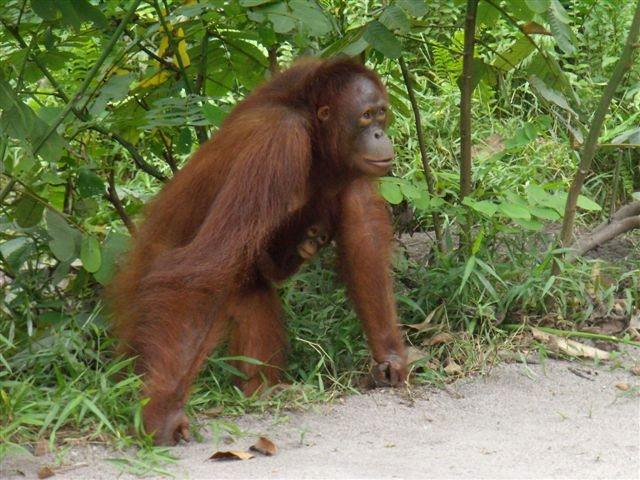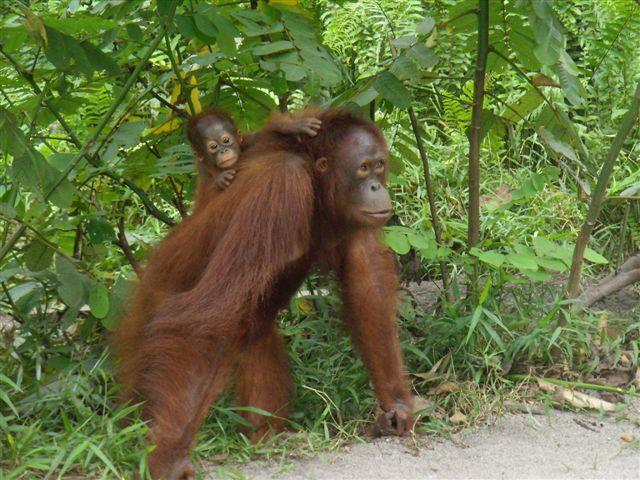My every sense says the forests on the northern border of the Lamandau Wildlife Reserve are in trouble. Already split into thin fingers of forest, separated by degraded areas, it seems these forests are retreating not expanding. However, with the support of local communities, we have chosen this area as a reforestation site. A few days ago I went there with Rene Dommain, the visiting German peat researcher, and we stayed at the very northern point of the Reserve, where we have a guard post, Post Prapat (see map).
Behind the post is one of the fingers of forest. Here there are tall trees, including those species found in deep forest, but they are only 20 metres away from sand. Clearly this is remnant primary forest and the thinner it gets, the more vulnerable it becomes.
Aerial view of Post Prapat with the remnant forest behind.
Rene helped to explain the process and no surprises here – the villain was fire. Whilst he described it as an “anthropogenic impact”, you and I can hear “man made”. The southern part of Borneo is a relatively “young” landscape. The base material is sand, deposited either from erosion of the high interior mountains or during the periods when the area was an ancestral seabed. Over thousands of years, grasses, shrubs, and then trees gradually covered the sand and forests grew.
Fires have had a major impact on this ecosystem. The first fires burning through the shallow humus layer, killing the trees’ roots. With the trees fallen the next fires to occur were even more destructive with subsequent fires encouraging scrub growth. Ultimately this left an exposed layer of sand with the original nutrient rich humus having been destroyed. Presently, these remaining forests are just waiting for the next dry year, the next fire.
The aim of the reforestation programme is not ambitious – even in our wildest dreams we cannot envisage the day when this will be thick forest. What we are trying to do is broaden the forested fingers, reduce the gaps and push the balance in favour of the trees not the scrub.
It is a tall order to regenerate this area, but you know us, we like a challenge!
We have established a tree nursery at Post Prapat. The people from the surrounding communities have been enthusiastic in finding wildings (seedlings harvested from wild seed-fall) to stock it. We will keep the trees in the nursery until their rooting systems are well established.
Nursery
The whole process is hugely resource-intensive and the return may be as little as 50ha (1/2 km2 or 123 acres). But that is hardly the point. The real points are:
- People learn about how fragile these ecosystems are.
- We are demonstrating that protecting the existing forest is much more effective than trying to re-grow it
- By protecting the fragile fringes, you prevent damage spreading to the core
In the case of Lamandau, the forest core is still rich in biodiversity. I led Rene on the 7 km walk southwards from Post Prapat to Camp Rasak. On the way, we saw a few birds and a snake. At Camp Rasak, I was hoping to catch of glimpse of Boni who we are told is seen most days and neither did we see Andi and Sawit, who seem to have gone off together (see post 'More orangutans back in the wild'). However we were fortunate to see Lady Di and her baby.
Lady Di was released into Lamandau in Febuary 2006 and this is her first baby.
It is hard to believe our reforestation programme site is only 7 km away, but without this added protection, this forest and these orangutans would seem a lot more vulnerable.
- PS, Sheryl, you’ll be pleased to know once the eagle, snake and monkeys were out of the traps, I also set the fish free :-)
We are participating in WildlifeDirect's business strategy. Please help us by taking this user survey, thank you.









